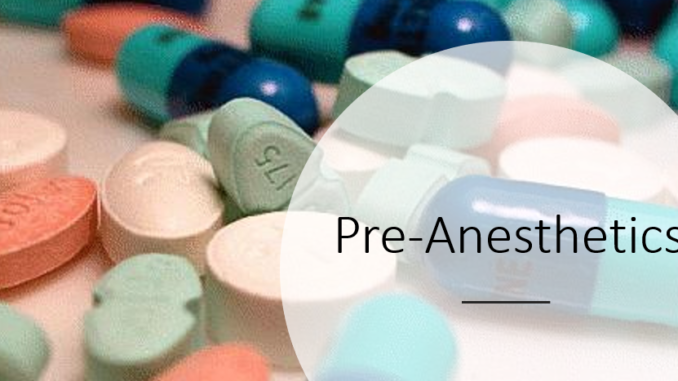
What are Pre-Anesthetics?
Pre-Anesthetics are used prior to anesthetic agents to make anesthesia safer and more agreeable to patient. Pre-operative period can be stressful for patients, mostly in case of children’s surgery. An ideal pre-anesthetic medication should facilitate patient acceptance of the face mask during induction of anesthesia without prolonging emergence, increasing cardiorespiratory instability, or postoperative delirium, nausea, and vomiting.
Reasons for using pre-anesthetics medication
-To produce sedation
-For counteracting adverse effects of anesthetics like vomiting, salivation
-To reduce pre-operative and post-operative pain
-For smooth and rapid induction
-To reduce dose of general anesthesia
There is no single drug which can achieve all these objectives, so combination of drugs is used. Other factors like preoperative visit by doctors and sympathetic discussion with patient about the event of next day also have high therapeutic value.
The drugs which are commonly used as pre-anesthetics are:
1)Opioid and non-opioid analgesics
Non-steroidal anti-inflammatory drugs like acetaminophen may be used along with or before anesthetics during minor surgeries. Opioid analgesics like morphine, pethidine, fentanyl etc. are used for their sedative and analgesic properties before minor surgeries. The beginning of this use of narcotic was probably in 1850 when Lorenzo Bruno of Turin first mentioned use of morphine as hypnotic agent prior to the induction of anesthesia. Narcotics have many undesirable side effects like delay of awakening, antidiuresis, tachycardia etc. Continued routine use of narcotics for pre-anesthetic mediation is unwise and unwarranted.
2)Sedatives and tranquilizers
Sedatives and hypnotics are used in majority of patients with oral benzodiazepine the most frequently used drugs. Benzodiazepines are commonly used because of their safety, muscle relaxant property and less respiratory depression. Midazolam, diazepam and lorazepam are most commonly used benzodiazepines. Midazolam is administered intravenously and can be given through oral, intramuscular or rectal route. Oral midazolam is particularly useful for sedation of young children.
Other tranquilizers used are phenothiazines like promethazine, trimeprazine. They can be given orally as well as parenterally. They possess sedative, anti-emetic, anti-arrhythmic properties. Hypotension is the most frequent disadvantage of phenothiazines
Phenothiazines and benzodiazepines should not be used with opioids in patients with respiratory insufficiency.
3)Antimuscarinic Drugs
Atropine, glycopyrronium and hyoscine are used to reduce salivary and respiratory secretions. They are mostly given through oral and intramuscular routes. Atropine is most commonly used along with morphine. Glycopyrrolate is more preferred because of its fewer central actions and less chances of causing tachycardia.
4)Antiemetics
Commonly used phenothiazines such as promethazine and trimeprazine possess antiemetic properties which help to reduce post-operative vomiting. Other anti-emetics like ondansetron, cyclizine can also be used. Dorperidol and metoclopramide also reduce incidence of post-operative emetic symptoms. However, they possess side effects like respiratory depression, delayed anxiety, extrapyramidal symptoms. Ondansetron is serotonin antagonist that selectively inhibit 5-HT3 receptors. It doesn’t possess histamine, adrenergic, cholinergic and dopamine activity. It is given through IV route.
Certain drugs need to be discontinued prior to surgery. Combination oral contraceptives are advised to be stopped 4 weeks before surgery, mono-amino oxidase inhibitors 2 weeks before surgery, warfarin 3-5 days before surgery and aspirin 7 days before surgery.
References
- James E. Eckenhoff, Martin Helrich. STUDY OF NARCOTICS AND SEDATIVES FOR USE IN PREANESTHETIC MEDICATION. 1958;167(4):415-422.
- Ellis N. Cohen, Henry K. Beecher. NARCOTICS IN PREANESTHETIC MEDICATIONA CONTROLLED STUDY. 1951;147(17):1664-1668.
- R K Mirakhur. Preanaesthetic Medication: A Survey of Current Usage. Journal of The Royal Society of Medicine. 84(8):
- John W.Dundee, James Moore, William J., Robert M.Nicholl Richard, S.J.Clarke. Studies of Drugs Given Before Anaesthesia VI: The Phenothiazine Derivatives. British Journal of Anesthesia. 37(5):332-353.
- Pan, Peter H. Moore, Charles H. Intraoperative Antiemetic Efficacy of Prophylactic Ondansetron Versus Droperidol for Cesarean Section Patients Under Epidural Anesthesia. 83(5): 982-986.
- K.MIRAKHUR, J.W.DUNDEE, J.D.R.CONNOLLY M.B. STUDIES OF DRUGS GIVEN BEFORE ANAESTHESIA XVII: ANTICHOLINERGIC PREMEDICANTS. British Journal of Anesthesia. 51(4):339-345.
- Pharmacology and Pharmacotherapeutics book, R.S. Satoskar. Page no- 109-122.
- Goodman and GILLMAN’S Manual of Pharmacology and Therapeutics. Page no- 221-241.